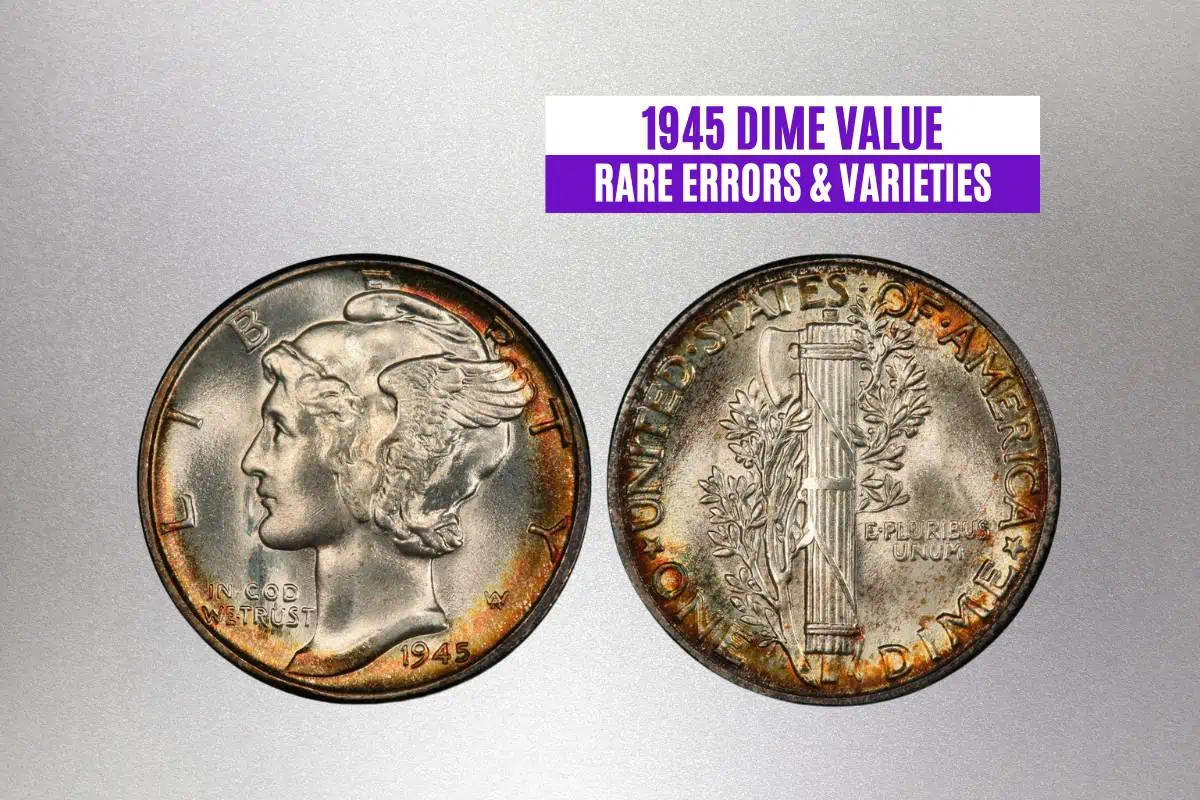Unlike the penny and nickel, the dime was a slightly later addition to the U.S. coinage system, first appearing in 1796. But today, it’s one of the longest-lived and most recognizable coins.
Still, U.S. ten-cent coins haven’t always featured an image of President Franklin D. Roosevelt. The 1945 Mercury dime is a prime example, and its current worth might surprise you.
Although this coin had an initial value of $0.10, it’s worth far more nowadays. In this guide, we’ll delve into the 1945 dime value, helping you understand which of these ten-cent coins are the most (and least) valuable.
1945 Mercury Dime Value Chart
| Variety | MS-63 | MS-65 | MS-67 |
| 1945-P Dime | $12 | $30 | $75 |
| 1945-P Dime FB | $3,750 | $12,750 | $47,000 |
| 1945-D Dime | $13 | $30 | $70 |
| 1945-D Dime FB | $20 | $50 | $220 |
| 1945-S Dime | $14 | $30 | $170 |
| 1945-S Dime FB | $23 | $110 | $440 |
| 1945-S Micro-S Dime | $40 | $110 | $445 |
| 1945-S Micro-S Dime FB | $85 | $615 | $3,300 |
1945 Mercury Dime: History
The U.S. ten-cent coin went through several iterations before reaching the Mercury (Winged Liberty Head) design. This design was initially introduced in 1916, and its final year was 1945.
As a result, the 1945 Mercury dime is a historically significant coin. Because 1945 was the last year the U.S. Mint produced the Mercury dime, many of the dimes struck during that year are of much higher quality than the previous years’ dimes.
For example, all mintages of the 1945 Mercury dime come in Full Band varieties. These coins are generally more valuable due to their reverse (back) face designs, which depict full banding across the raised image. Their reliefs are more striking and detailed, making them sought-after collector’s pieces.
1945 Mercury Dime: Design
Adolph Alexander Weinman, a German-American sculptor, created the Mercury dime design.
Weinman also produced several sculptures for buildings throughout New York City. Still, his U.S. half dollar and dime designs remain his greatest legacies, with the Winged Liberty Head often heralded as the most aesthetically-pleasing dime design ever adopted by the U.S. Mint.
However, Weinman probably took issue with his dime design’s colloquial nickname. After all, the common person looked at the Winged Liberty Head design and saw Mercury (the Roman god), not a young Lady Liberty with a winged cap. So, although he was praised for his talent, there might have been a little bitterness toward the coin’s long-lasting nickname and public perception.
1945 Mercury Dime Obverse
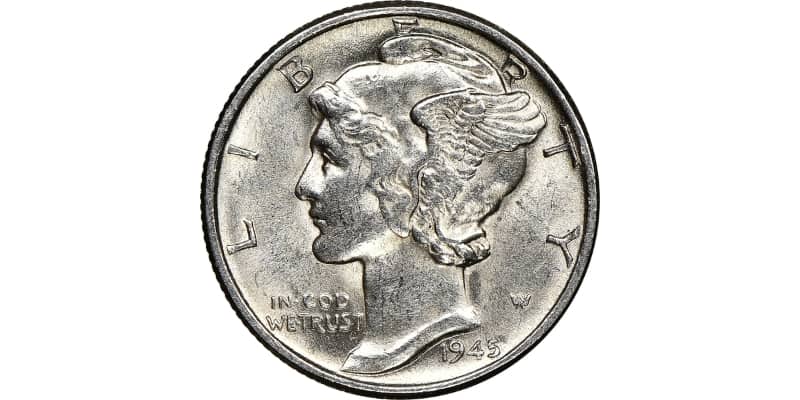
When examining the obverse (front) side of the 1945 Mercury dime, you’ll notice the following design elements:
- The legend “LIBERTY” on the top of the coin, arching downward above the device
- The raised image (device) of Lady Liberty, face in profile facing left, wearing a winged cap (center of the coin)
- The motto “IN GOD WE TRUST” on the lower left-hand side of the coin, somewhat parallel with Winged Liberty’s neck
- The year date (1945) beneath the image of Winged Liberty, slightly off-center toward the right
1945 Mercury Dime Reverse
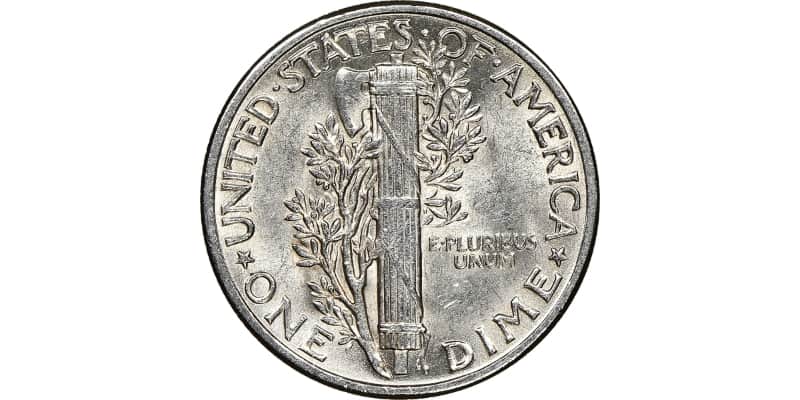
When examining the reverse (back) side of the 1945 Mercury dime, you’ll notice the following design elements:
- The issuing nation “UNITED STATES OF AMERICA” on the top of the coin, arching downward
- The raised image (device) of a bound bundle of sticks with an axe erupting from its left side (called a fasces) and a large olive branch that appears to wrap from the bottom left to upper right side of the structure
- The motto “E PLURIBUS UNUM” on the right side of the coin, just below the center point
- The coin designation “ONE DIME” on the bottom of the coin, arching upward
- The mint mark (S or D) between the “ONE” and “DIME” coin designation, just below the device’s olive branch stem
1945 Mercury Dime: Features and Specifications
The 1945 Mercury dime varies in design in two major ways: mint marks and the presence of a Full Band reverse design. That said, these coins are more alike than they are different.
For example, all non-error 1945 Mercury dimes (or, should we say, Winged Liberty Head dimes):
- Weigh 2.5 grams (about 0.09 ounces)
- Are 17.9 millimeters (about 0.7 inches) in diameter
- Are made of 10% copper and 90% silver
- Have ridged (reeded) edges
How Much Is a 1945 Mercury Dime Worth?
According to the NGC Price Guide, a 1945 No Mint Mark Mercury dime (1945-P Mercury dime) is worth about $3 in good condition (G-4) and $3.65 in about uncirculated (AU-50) condition. But a 1945 No Mint Mark Mercury dime can be worth much more, with some pieces valued at between $7 (MS-60) and $1,400 (MS-68).
1945 Mercury Dime: Value Comparison
Whether you have several 1945 Mercury dimes in your collection or want to add some, it’s crucial to familiarize yourself with the values of these coins. However, the value of any given 1945 Mercury dime heavily depends on its:
- Condition (represented via a PCGS or NGC grade)
- Design (whether it has the Full Band design or not)
- Mint mark
To help you determine the worth of this ten-cent coin, let’s explore the values of each mint mark.
1945 No Mink Mark Mercury Dime Value
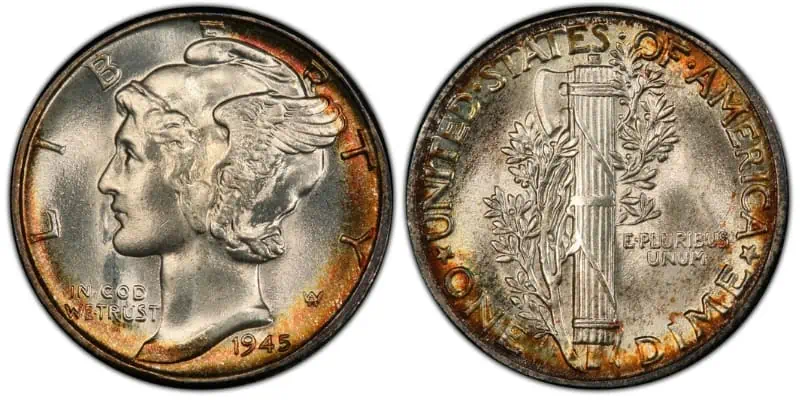
Coins produced at the Philadelphia Mint typically lack a mint mark, giving them the name “No Mint Mark” coins. In 1945, the Philadelphia Mint struck more than 159 million Mercury dimes, more than any other U.S. Mint facility.
These dimes vary in value, with those in good condition (G-4) have an approximate worth of $3. But 1945 No Mint Mark dimes in about uncirculated condition (AU-50) are worth slightly more, with an estimated value of $3.65.
Uncirculated condition (mint state) 1945 Mercury dimes struck at the Philadelphia Mint are even more valuable. An MS-60 No Mint Mark dime from 1945 is worth about $7, while an MS-68 is worth $1,400 or more.
Still, the Full Band variety is generally worth more than standard regular strike dimes. This isn’t only true of Mercury dimes struck in Philadelphia but all 1945 Mercury dimes.
Full Band Value
Like proof coins, the 1945 No Mint Mark Full Band Mercury dime is almost always found in exceptional mint state condition. An MS-60 1945 No Mint Mark FB dime is worth about $1,100, while an MS-67 piece has an estimated value of $47,000!
1945-D Mercury Dime Value
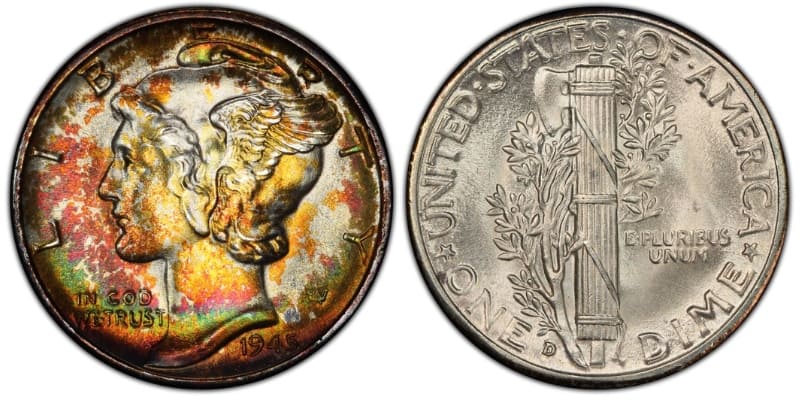
The Denver Mint struck more than 40 million Mercury dimes in 1945, coming in at slightly below the volume of the San Francisco mint. Consequently, the 1945-D Mercury dime is one of the rarest 1945 dimes, with an estimated surviving population of only 35,000 pieces.
You can identify these dimes by the small “D” mint mark on the coin’s bottom reverse side.
In good condition (G-4), a 1945-D Mercury dime is worth about $3. In about uncirculated condition (AU-50), this value jumps up to $3.75. Still, as with most regular strike coins, the highest-value examples are those in mint state (MS) condition.
For example, an MS-60 1945-D Mercury dime is worth about $7.50, while an MS-68 version has an approximate value of $585. 1945-D dimes showing the Full Band reverse design are worth much more.
Full Band Value
A 1945-D Full Band Mercury dime is worth $8.50 in MS-60 condition. This makes it only worth about a dollar more than a non-Full-Band 1945-D dime of the same grade. But value differences become more apparent with higher-grade coins.
If you had a 1945-D FB Mercury dime in MS-68 condition, you could expect to sell that coin for $6,500 or more. That’s a much higher value (by almost $6,000) than a similarly-graded non-FB 1945-D dime.
1945-S Mercury Dime Value
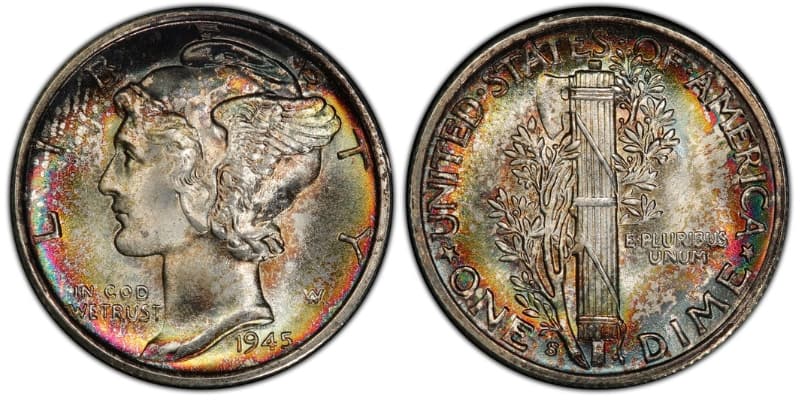
The San Francisco Mint struck about 41.9 million dimes in 1945. About 45,000 are thought to be around today. The values of these coins vary depending on the presence of the Full Band design and the size of the “S” mint mark (regular or micro).
A regular strike, regular mint mark, non-Full-Band 1945-S Mercury dime is worth about $3 in good condition (G-4) and $3.60 in about uncirculated (AU-50) condition. In mint state condition, values vary between $6 (MS-60) and $850 (MS-68).
Rare MS-69 coins are the most valuable of the non-FB, regular mint mark 1945-S Mercury dimes. An MS-69 1945-S dime is worth about $1,650.
Full Band Value
The Full Band 1945-S Mercury dimes are only available in mint state condition. The value of these coins varies between $9 (MS-60) and $9,950 (MS-68). As such, FB 1945-S dimes are worth slightly more than Full Band dimes struck at the Denver Mint during the same year.
Micro S Value
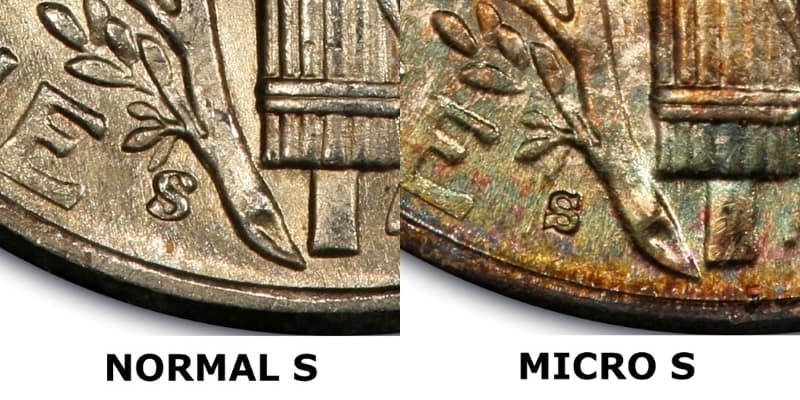
The “Micro S” 1945 Mercury dime is so-called because it features a smaller “S” mint mark than most dimes struck at the San Francisco Mint facility. This smaller “S” results from reusing older coin dies, though it’s not a rare alteration when it comes to 1945 Mercury dimes.
As such, a Micro S 1945-S dime is worth $2.75 in good condition (G-4), $15 in about uncirculated condition (AU-50), and up to $2,400 in uncirculated condition (MS-68).
The Full Band Micro S 1945-S Mercury dime is slightly more valuable. In MS-60 condition, one of these FB dimes can sell for upwards of $35. And in MS-68 condition, an FB Micro S 1945-S Mercury dime can sell for $19,750 or more!
1945 Mercury Dime: Rare Errors
The coin-minting process is always improving, with significant technological revolutions making it easier than ever for the U.S. Mint to produce high-quality coins. But this process is never perfected, and error coins occasionally make their way into circulation.
When discussing the 1945 Mercury dime, a handful of rare errors are worth mentioning. After all, these coins can be worth far more than their standard non-error counterparts.
The most notable rare errors associated with the 1945 Mercury dime include the following:
- 1945 Mercury Dime Bolivar Planchet Error
- 1945 Mercury Dime Broadstruck Error
- 1945 Mercury Dime Off-Center Error
- 1945 Mercury Dime Netherlands Planchet Error
Let’s explore these error coins in greater detail to discover their identifying features and estimated values.
1945 Mercury Dime Bolivar Planchet Error
Although the U.S. Mint primarily produces U.S. coinage, it has lent its services to other countries throughout the years. For example, in the 1940s, the U.S. Mint produced Venezuelan bolivars.
These coins share several characteristics with Mercury dimes, including high silver content. However, the 1945 Venezuelan bolivar features a different size and weight, being slightly heavier and wider than the Mercury dime of the same year.
Still, at first glance, it can be challenging to tell a bolivar planchet (a blank metal disc used to produce coins) from a dime planchet. Perhaps this easy confusability is what led to the bolivar planchet error.
The 1945 Bolivar Planchet Mercury dime error is a rare coin that features the design of the 1945 Mercury dime but the planchet of a Venezuelan bolivar. It’s unknown how many of these error coins the U.S. Mint created. But in 2022, an MS-64 example sold at auction for $6,600.
Professional grading services (PCGS or NGC) can help you find out if you have one of these rare error coins.
1945 Mercury Dime Broadstruck Error
Broadstruck coins are often wider than non-error coins. This is because these coins flatten more than they should during the striking process, typically due to the absence of a collar (a piece that keeps the planchet contained during minting).
A handful of 1945 Mercury dimes feature the broadstruck error, including one that sold for $4,560 in 2018. Still, not all broadstruck 1945 Mercury dimes are as valuable.
The coin that sold for thousands in 2018 was partially expensive because of its rare error. However, it’s important to note that its mint state condition (MS-65) and Full Band designation also boosted its value.
1945 Mercury Dime Off-Center Error
Sometimes, coin planchets aren’t precisely lined up with the coin dies during minting. When this happens, the dies strike the coins incorrectly, producing off-center designs.
Off-center coins are often some of the most common error coins, but their values vary significantly.
Error percentage is one of the most influential factors impacting the value of an off-center Mercury dime. Smaller-percentage off-center strikes can make a coin slightly more valuable than larger ones.
So, while a 10% off-center 1945 Mercury dime might sell at auction for about $3,000, a 20% off-center piece might only sell for $2,000.
1945 Mercury Dime Netherlands Planchet Error
As with the bolivar error dime, the 1945 Netherlands Planchet Mercury dime error results from the wrong type of planchet being fed beneath dime coin dies.
But unlike the Venezuelan bolivar, which was wider than the Mercury dime, the Netherlands ten-cent coin planchet was a little smaller than its U.S. counterpart. Consequently, the 1945 Netherlands Planchet Mercury dime error looks similar to an off-cent dime, as the full dime design couldn’t fit onto the foreign coin planchet.
Although it’s uncertain how many of these coins exist, at least one thing is for sure; this error coin can be exceptionally valuable. In 2018, one of these wrong-planchet coins sold at auction for $2,640.
Like other Mercury dime coin errors, a reputable coin grading service can determine whether your Mercury dime is one of these elusive pieces.
Frequently Asked Questions
If you’re a numismatist, there’s an excellent chance that you’re at least somewhat familiar with the Mercury dime. But there’s always something new to learn about retired coins, including the 1945 Mercury dime. These frequently asked questions (and answers) are a great resource, so check them out!
How Many 1945 Mercury Dimes Exist Today?
Millions of Mercury dimes were struck in 1945, but only about 125,000 are thought to exist today. The actual number of surviving coins could be much higher. This estimate is pulled from the number of coins annually graded by PCGS and NGC, so coins that have remained ungraded and kept in long-standing private collections could boost this initial figure.
Does the 1945 Mercury Dime Have Full Bands?
Some 1945 Mercury dimes have full bands on their reverse (back) faces, but this isn’t true of all 1945 dimes.
The 1945 No Mint Mark Mercury dime (struck in Philadelphia) is more likely to show full bands than coins struck in San Fransisco or Denver. That said, “Full Band” (FB) varieties exist across all three major types of 1945 Mercury dimes.
What’s the Most Ever Spent on a 1945 Mercury Dime?
The most ever spent at auction for a 1945 Mercury dime is $96,000. This record was set in January 2018 for an MS-67+ Full Band piece. If this exquisite-quality dime ever goes to auction again, it’ll likely sell for a much higher price.
Final Thoughts
The 1945 dime value has steadily risen over the last several decades. That’s because this coin is 90% silver (making it inherently valuable), the last year for the Mercury dime (making it historically significant), and one of the highest-quality strikes for the design (with many coins featuring the Full Band reverse design).
The 1945 Mercury dime’s worth varies between $3 in good condition (G-4, all mint marks) and $47,000 (No Mint Mark, Full Band, MS-67). Rare error coins can also fetch impressive prices, often selling for thousands of dollars.
Discover more about coin values by checking out these related articles!

